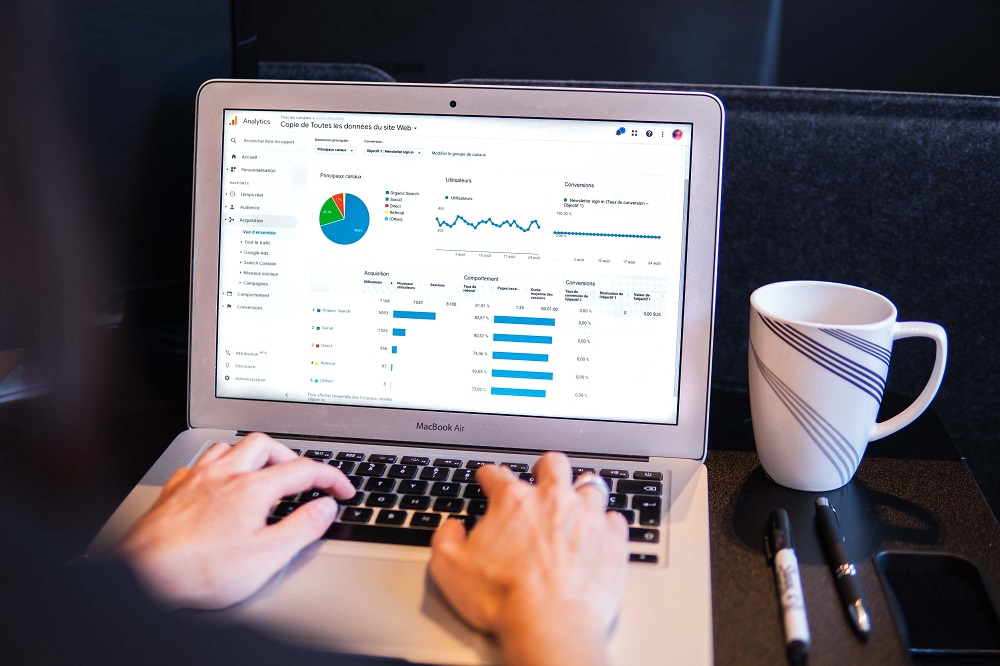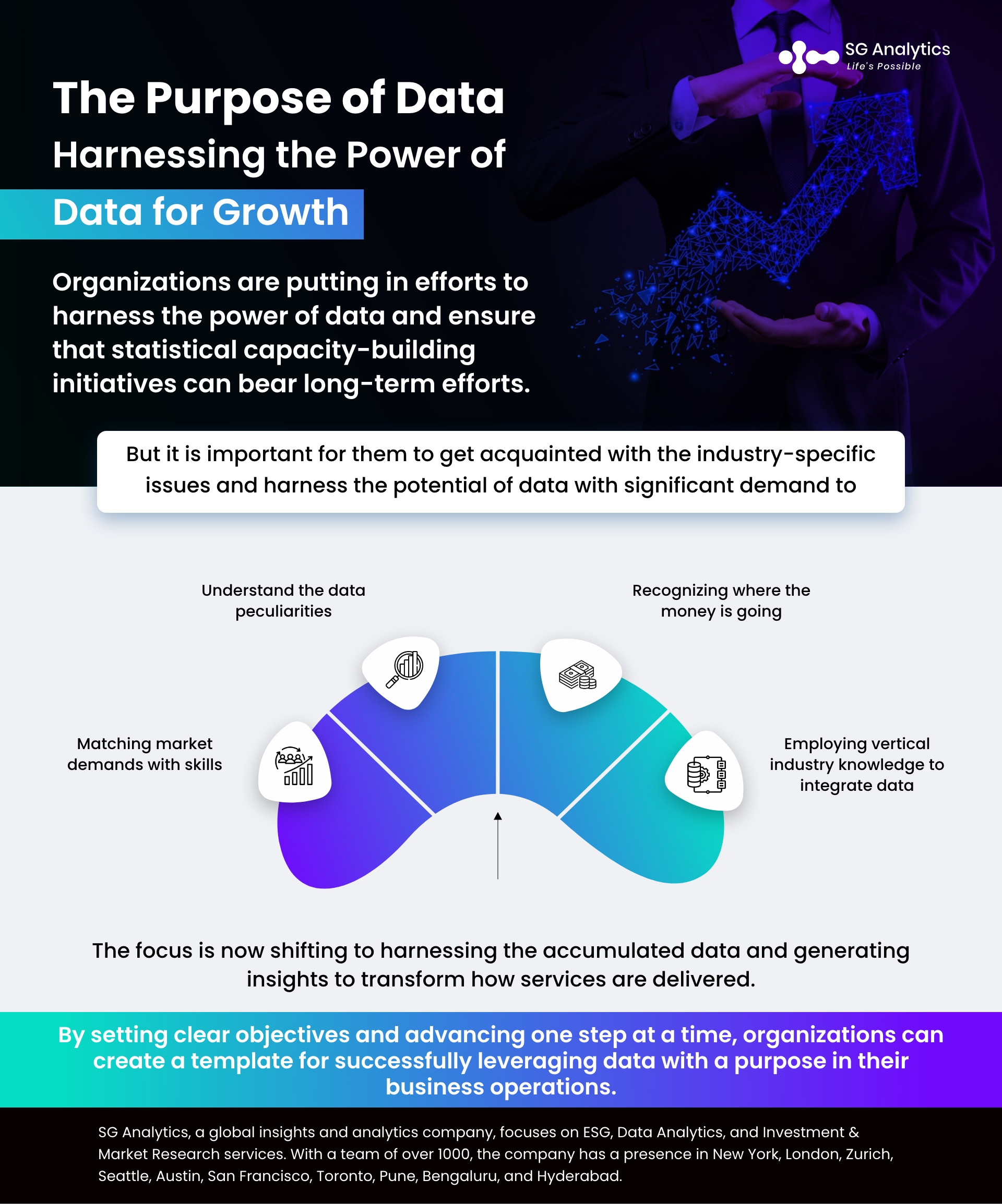In today’s competitive business landscape, many organizations are relying more and more on data to drive their decision-making processes. With the growth of data being generated from various sources, businesses are facing the challenge of extracting valuable insights from this vast pool of data.
There is an urgent need to make better use of data and analytics, which has catapulted many organizations into the next stage of digital maturity.
Introduction to Data with Purpose: Data is Everywhere
With organizations having the foundational technologies in place, more data is being collected ad processed. The focus is now shifting to harnessing the accumulated data and generating insights that can transform how services are delivered, thereby improving outcomes. Even governments and public sector organizations are recognizing the need to integrate digital technologies and reliable data sets to improve their operations - from planning to commissioning and delivery - and outcomes.
However, the potential of embarking on his journey is quite daunting.

Businesses today are treating having more data as a necessary good. But the collected data does nothing by itself. The data should be processed and managed with the goal of uncovering insights that help in perfectly representing business-oriented outcomes. By gaining an understanding of the goal of data, organizations can provide objective descriptions of factual business activities and explore new avenues to understand the data distinction in a new light.
The Components of Data with Purpose
Data that is collected particularly can be employed for further improvements. It is critical to shed light on the concept of intentional data, especially with the rapidly increasing amounts of data being gathered. The organizational goal should be to end up with data sets that could be referred to as intelligent data.
However, they need to narrow down their understanding of the purpose of data as it will help in navigating the jungle of dark data and making more sense of it. The data should not only be accurately descriptive but also point toward action through intentional collection.
By incorporating an integrated approach towards harnessing the power of data with purposes, organizations are establishing transparent frameworks along the data value chain - from origination, aggregation, and management to modernization and insights generation. This is further equipping them to harness data and map it to specific purposes for driving maximum value for stakeholders.
Read more: How are Organizations Benefiting By Turning Data into Purpose?

The Growing Global Data Market
The global data market incorporates organizations offering IT consulting and system integration services, as well as data processing services, business outsourcing, and Internet services. The global IT market encircles companies that offer information technology consulting and information management solutions. The global data market can be fragmented into the following-
-
Bargaining power of buyers
-
The threat of data theft
-
Identifying new customers
-
Understanding the power of suppliers
Today every business and organization has access to data that can be leveraged to create valuable insights. With the growing popularity of tech like artificial intelligence (AI), data is becoming even more accessible. Organizations are integrating big data solutions into their operations to benefit from the data potential. However, it is important for them to get acquainted with the industry-specific issues and harness the potential of data with significant demand to –
-
Understand the data peculiarities
-
Recognizing where the money is going
-
Matching market demands with skills and offerings.
-
Employing vertical industry knowledge to integrate data.
By integrating analytical tools, organizations are working towards unlocking the potential of their accumulated data to stay ahead of the competition. These analytical tools are further empowering businesses to discover hidden patterns, trends, and relationships within their data to improve overall performance. Today with the increasing importance of data-driven decision-making, the adoption of data analytical tools is also on the rise.

Key Characteristics of Purposeful Data: Making Data Fit for Purpose
New technological advancements are assisting organizations and data leaders in handling the growing needs of data. There is also a growing opportunity for them to increase the consolidation of data management by delivering operational and analytical needs. However, organizations need to incorporate and apply new approaches and frameworks to broaden their view on data needs and ensure that the data is fit for purpose:
-
Fit for the purpose from a data quality standpoint.
-
Fit for purpose for the user to take action.
-
Fit for the purpose so that the current data is enough to form the basis for the use.
Once organizations can really discover the purpose of their data, they can integrate measures to define how the data fits the purpose and take action on the findings.
Organizations are further implementing innovative data projects for the collection and analysis of data. The modernization of data governance along with data quality frameworks - by merging new data sources with traditional ones - is further ensuring organizations establish transparent mechanisms.
Read more: Data Transparency: An Ultimate Guide to Building Data Trust

Establishing Data Transparency
Organizations need to specify what data is being used or shared, along with the purpose of the data. This enables the user to see the benefits and make their judgments about the value of data sharing as well as analytics.
By creating robust data quality and governance frameworks, organizations can safeguard as well as improve the richness and relevance of data. Strict rules are being adopted to govern data access as well. Successful organizations are taking further steps to enhance the data quality, richness, and relevance, making it fit for analysis. This ensures data relevance and quality, including data cleansing to clear errors, duplications, or conflicting information. The proliferation in the scale and availability of data raises concerns about how to access data and what rules and regulations should be in place to protect the data.
A robust information governance (IG) approach is equally fundamental for the success of analytics solutions. Organizations can link their data sets in a central way to protect the accumulated information. This technique helps in aggregating data and details.
Fostering Innovations Across Data Ecosystems
Visual information promotes data exploration and processing for evidence-based decision-making. With data visualization, businesses can connect with data on sustainable development, thereby enabling them to discover, understand, and communicate patterns in the wealth of data and statistics that are available. By recognizing the policy context and new data management frameworks, organizations can foster innovation while also providing continuity and facilitating interoperability among data providers and users.

Truly innovative organizations are aware that the data analytics journey is never completed. With every data-driven project, there is a need for new exploration and progress. To harness the power of data, organizations are establishing community-wide aggregated data lakes, identifying further data sets, and developing advanced functions like real-time data visualization.
Through various institutional arrangements, organizations are fostering public-private partnerships to enable the use of big data and other non-traditional data sources in policymaking. By mainstreaming their use in official statistics by data providers and outsourcing certain functions, they are continuing to advance the design and implementation of their business models and further encourage effective partnerships to improve the availability and quality of data for development.
Read more: Data as a Growth Enabler: Finding the Real Purpose of Data
The World Through Data Lense
Accelerated discovery within an organization requires the integration of multiple complex workflows. While it is challenging, the data needs to be made available in order to define the data placement for further data collaboration. It is equally important to ensure that the data placement is flexible, dynamic, and easy to share. By delivering data with known quality, organizations can validate and describe the consumer's perspective. However, the data needs to be made available in a way where it is easily consumed whenever required - whether for discovery or any other purposes.

To fully monitor and implement progress on the accumulated data, decision-makers need to generate accurate statistics that are accessible, timely, relevant, and sufficiently disaggregated. Data quality and availability have steadily improved over the years. However, there is still a need to strengthen and enhance data literacy at all levels of decision-making. However, this will require coordinated efforts from multiple data solutions and demand innovative ways to apply data and statistics to address the multifaceted challenges.
Key highlight
-
There has been an increase in the imperative for organizations to develop data and analytics initiatives to safeguard the collected data,
-
System-level enablers are incorporating data strategies and frameworks to improve their data-sharing needs.
-
These key enablers are equipping organizations to define the purpose of their data, build data transparency and trust, and obtain data-driven insights.
Summary: Harnessing the Potential of Data with Purpose
The scope of traditional data capacity building is widening, leading to nurturing collaboration and synergies across complex data systems. The goal is to mainstream data innovations with a sharp focus on users’ needs. Organizations are putting in efforts to harness the power of data and ensure that statistical capacity-building initiatives can bear long-term efforts. This further facilitates businesses in budgeting and monitoring their development activities across key departments.
Read more: How are Organizations Creating and Cultivating a Data-Driven Culture?
By establishing data standards and best practices, organizations can evolve in parallel with available technology and users' requirements. The focus should be on new data standards that would further enable organizations to build upon existing ones and facilitate rapid scale-up among stakeholders from both the public and private spheres.

While the road ahead to the future of data with purpose may seem daunting, organizations need to identify the power of making a start and designing a roadmap to demonstrate expected benefits and break down siloes. The future of improved insights encompasses integrating data sets and identifying the potential benefits that data can bring. This involves enhancing the accuracy of the data, adding new data sources, and establishing a more data-led framework within the organization.
By setting clear objectives and advancing one step at a time, organizations can create a template for successfully leveraging data with a purpose in their business operations.
With a presence in New York, San Francisco, Austin, Seattle, Toronto, London, Zurich, Pune, Bengaluru, and Hyderabad, SG Analytics, a pioneer in Research and Analytics, offers tailor-made services to enterprises worldwide.
A leader in Data Analytics, SG Analytics focuses on leveraging data management and analytics, and data science to help businesses discover new insights and build strategies for business growth. Contact us today if you are looking to make critical data-driven decisions to prompt accelerated growth and breakthrough performance.
About SG Analytics
SG Analytics is an industry-leading global insights and analytics firm providing data-centric research and contextual analytics services to its clients, including Fortune 500 companies, across BFSI, Technology, Media and entertainment, and Healthcare sectors. Established in 2007, SG Analytics is a Great Place to Work® (GPTW) certified company and has a team of over 1100 employees and has presence across the U.S.A, the U.K., Switzerland, Canada, and India.
Apart from being recognized by reputed firms such as Analytics India Magazine, Everest Group, and ISG, SG Analytics has been recently awarded as the top ESG consultancy of the year 2022 and Idea Awards 2023 by Entrepreneur India in the “Best Use of Data” category.









